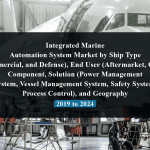OVERVIEW
The Airport Automation Market is currently valued at USD 5.8 billion in 2024 and will be growing at a CAGR of 5.8% over the forecast period to reach an estimated USD 7.7 billion in revenue in 2029. The airport automation market is witnessing rapid growth driven by technological advancements and increasing demand for efficient airport operations. Automation solutions are revolutionizing various aspects of airport management, including check-in, baggage handling, security screening, and passenger assistance. These solutions leverage cutting-edge technologies such as artificial intelligence, robotics, and IoT to streamline processes, enhance security, and improve the overall passenger experience. From self-service kiosks to automated baggage handling systems, airports are increasingly adopting automation to optimize resource utilization, minimize delays, and reduce operational costs. Moreover, the rising trend of smart airports and the integration of biometric identification systems are further propelling market expansion as airports strive to meet growing passenger expectations for seamless travel experiences.
The increasing passenger traffic and growing demand for air travel worldwide are compelling airport authorities to adopt automation solutions to manage the influx efficiently. Secondly, the need to enhance operational efficiency and reduce costs is driving airports to invest in automation technologies that streamline processes such as check-in, baggage handling, and security screening. Thirdly, advancements in technology, particularly in areas like artificial intelligence, robotics, and IoT, are enabling the development of innovative automation solutions that offer improved accuracy, speed, and reliability. Additionally, the rising trend of smart airports and the growing focus on passenger experience are encouraging airports to invest in automation to deliver seamless and personalized services. Moreover, stringent security regulations and the need to enhance safety measures are driving the adoption of automated security screening systems and biometric identification technologies in airports.
Market Dynamics
Drivers:
The increasing passenger traffic and growing demand for air travel worldwide are compelling airport authorities to adopt automation solutions to manage the influx efficiently. Secondly, the need to enhance operational efficiency and reduce costs is driving airports to invest in automation technologies that streamline processes such as check-in, baggage handling, and security screening. Thirdly, advancements in technology, particularly in areas like artificial intelligence, robotics, and IoT, are enabling the development of innovative automation solutions that offer improved accuracy, speed, and reliability. Additionally, the rising trend of smart airports and the growing focus on passenger experience are encouraging airports to invest in automation to deliver seamless and personalized services. Moreover, stringent security regulations and the need to enhance safety measures are driving the adoption of automated security screening systems and biometric identification technologies in airports.
Key Offerings:
The airport automation market offers a diverse range of key offerings designed to enhance operational efficiency, improve passenger experience, and ensure safety and security within airport facilities. These offerings include automated check-in and boarding systems, self-service kiosks, and mobile applications that empower passengers to manage their travel journey seamlessly. Automated baggage handling systems optimize the handling and tracking of luggage, reducing the risk of mishandling and minimizing delays. Advanced security screening solutions, such as automated body scanners and biometric identification systems, enhance airport security while expediting the screening process for passengers. Additionally, airport automation encompasses air traffic management systems, which utilize data analytics and AI algorithms to optimize airspace usage, enhance flight efficiency, and reduce congestion. Furthermore, automation solutions for airport operations management, such as maintenance scheduling software and predictive analytics tools, enable airports to maximize resource utilization and minimize downtime.
Restraints :
The airport automation business is expanding, but there are a number of obstacles in the way of it reaching its full potential. One major obstacle is the large upfront cost of putting automation technologies into place, which can discourage smaller airports or those with tighter budgets. The aviation industry’s complicated regulatory framework and strict security requirements also make it difficult to integrate and implement new automation technology. Barriers include worries about cybersecurity and data privacy, especially in light of the growing use of biometric identification systems and digital platforms for passenger processing. Furthermore, standardisation and scalability of automation solutions may be difficult due to the various operating requirements and infrastructural constraints across various airports. Moreover, the adoption rate of automation may occasionally be slowed down by stakeholder and airport staff reluctance to change as well as the requirement for substantial training and assistance throughout the shift to automated procedures. In general, resolving these obstacles is essential to the further expansion and broad acceptance of automation in the aviation sector.
Regional Information:
• In North America, the airport automation market is driven by technological innovation and a strong emphasis on enhancing passenger experience and operational efficiency. Major airports in the region are increasingly investing in advanced automation solutions such as self-service check-in kiosks, automated baggage handling systems, and biometric identification technologies to streamline processes and reduce wait times. Moreover, stringent security regulations and the need for robust safety measures are propelling the adoption of automated security screening systems. In Europe, the market is characterized by a focus on sustainability and environmental initiatives, driving the adoption of automation technologies that improve energy efficiency and reduce carbon emissions.
• The European market is witnessing significant investment in smart airport infrastructure and digitalization to deliver seamless travel experiences.
• In the Asia-Pacific region, rapid urbanization, economic growth, and increasing air travel demand are fueling the expansion of the airport automation market. Airports in this region are investing in automation solutions to accommodate growing passenger volumes and improve overall operational efficiency.
Recent Developments:
• In June 2023, Pristina International Airport is implementing Amadeus’ Airport Management Suite (AMS) to effectively plan flight schedules up to one year ahead. The new operational systems will distribute and regularly update crucial flight data at strategic points throughout the airport. Additionally, they will introduce advanced optimization algorithms to enhance the management of commonly used airport facilities such as parking areas, departure gates, and check-in counters, benefiting the airlines operating from Pristina.
• In May 2023, Siemens Logistics GmbH a subsidiary company of Siemens has secured a contract to provide advanced baggage handling solutions for Terminal 2 at Hefei Xinqiao Airport in eastern China. In addition to VarioStore early bag storage solution, the innovative BagIQ software will be implemented to optimize system control.
Key Market Players:
Siemens AG, Honeywell International Inc., Thomas Group, SITA, Rockwell Collins, Amadeus IT Group SA, IBM Corporation, NEC Corporation, Cisco Systems, Inc., and Smiths Detection.
Frequently Asked Questions
1) What is the projected market value of the Airport Automation Market?
– The Airport Automation Market is expected to reach an estimated value of USD 7.7 billion in revenue by 2029.
2) What is the estimated CAGR of the Airport Automation Market over the 2024 to 2029 forecast period?
– The CAGR is estimated to be 5.8% for the Airport Automation Market over the 2024 to 2029.
3) Who are the key players in the Airport Automation Market?
– Siemens AG, Honeywell International Inc., Thomas Group, SITA, Rockwell Collins, Amadeus IT Group SA, IBM Corporation, NEC Corporation, Cisco Systems, Inc., and Smiths Detection.
4) What are the drivers for the Airport Automation Market?
– The increasing passenger traffic and global air travel demand are driving airports to adopt automation solutions to manage influx efficiently, reduce costs, and streamline processes. Advancements in technology, such as artificial intelligence and IoT, are enabling innovative automation solutions. Smart airports and stringent security regulations also drive the adoption of automated security systems.
5) What are the restraints and challenges in the Airport Automation Market?
– The airport automation market faces challenges such as high initial investment, complex regulatory environment, stringent security standards, data privacy and cybersecurity concerns, diverse operational requirements, and resistance to change. Addressing these restraints is crucial for the sustained growth and widespread adoption of automation in the airport industry. Despite these obstacles, the adoption of automation is expected to increase.
6) What are the key applications and offerings of the Airport Automation Market?
– The airport automation market offers various solutions to improve operational efficiency, passenger experience, and safety. These include automated check-in systems, self-service kiosks, mobile applications, baggage handling systems, advanced security screening solutions, air traffic management systems, and operations management tools. These technologies optimize airspace usage, reduce congestion, and maximize resource utilization.
7) Which region is expected to drive the market for the forecast period?
– North America is expected to have the highest market growth from 2024 to 2029
Why Choose Us?
Insights into Market Trends: Global Market Studies reports provide valuable insights into market trends, including market size, segmentation, growth drivers, and market dynamics. This information helps clients make strategic decisions, such as product development, market positioning, and marketing strategies.
Competitor Analysis: Our reports provide detailed information about competitors, including their market share, product offerings, pricing, and competitive strategies. This data can be used to inform competitive strategies and to identify opportunities for growth and expansion.
Industry Forecasts: Our reports provide industry forecasts, which will inform your business strategies, such as investment decisions, production planning, and workforce planning. These forecasts can help you to prepare for future trends and to take advantage of growth opportunities.
Access to Industry Experts: Our solutions include contributions from industry experts, including analysts, consultants, and subject matter experts. This access to expert insights can be valuable for you to understand the market.
Time and Cost Savings: Our team at Global Market Studies can save you time and reduce the cost of conducting market research by providing comprehensive and up-to-date information in a single report, avoiding the need for additional market research efforts.












